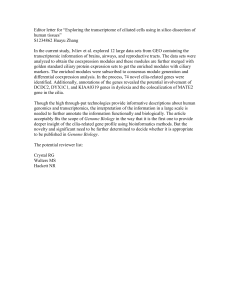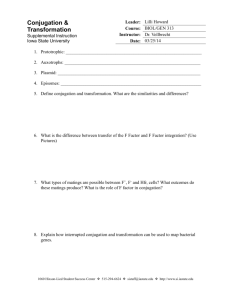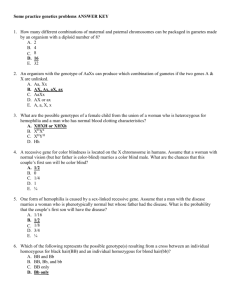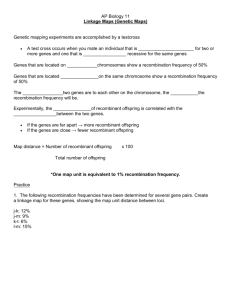1 - CORDIS
advertisement
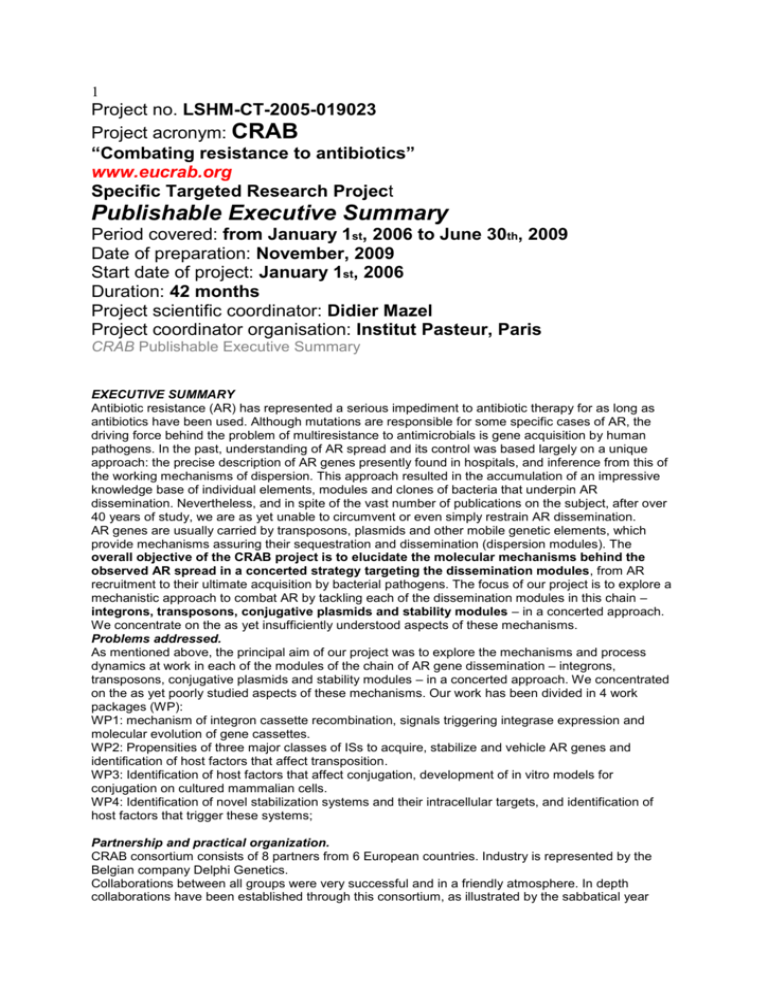
1 Project no. LSHM-CT-2005-019023 Project acronym: CRAB “Combating resistance to antibiotics” www.eucrab.org Specific Targeted Research Project Publishable Executive Summary Period covered: from January 1st, 2006 to June 30th, 2009 Date of preparation: November, 2009 Start date of project: January 1st, 2006 Duration: 42 months Project scientific coordinator: Didier Mazel Project coordinator organisation: Institut Pasteur, Paris CRAB Publishable Executive Summary EXECUTIVE SUMMARY Antibiotic resistance (AR) has represented a serious impediment to antibiotic therapy for as long as antibiotics have been used. Although mutations are responsible for some specific cases of AR, the driving force behind the problem of multiresistance to antimicrobials is gene acquisition by human pathogens. In the past, understanding of AR spread and its control was based largely on a unique approach: the precise description of AR genes presently found in hospitals, and inference from this of the working mechanisms of dispersion. This approach resulted in the accumulation of an impressive knowledge base of individual elements, modules and clones of bacteria that underpin AR dissemination. Nevertheless, and in spite of the vast number of publications on the subject, after over 40 years of study, we are as yet unable to circumvent or even simply restrain AR dissemination. AR genes are usually carried by transposons, plasmids and other mobile genetic elements, which provide mechanisms assuring their sequestration and dissemination (dispersion modules). The overall objective of the CRAB project is to elucidate the molecular mechanisms behind the observed AR spread in a concerted strategy targeting the dissemination modules, from AR recruitment to their ultimate acquisition by bacterial pathogens. The focus of our project is to explore a mechanistic approach to combat AR by tackling each of the dissemination modules in this chain – integrons, transposons, conjugative plasmids and stability modules – in a concerted approach. We concentrate on the as yet insufficiently understood aspects of these mechanisms. Problems addressed. As mentioned above, the principal aim of our project was to explore the mechanisms and process dynamics at work in each of the modules of the chain of AR gene dissemination – integrons, transposons, conjugative plasmids and stability modules – in a concerted approach. We concentrated on the as yet poorly studied aspects of these mechanisms. Our work has been divided in 4 work packages (WP): WP1: mechanism of integron cassette recombination, signals triggering integrase expression and molecular evolution of gene cassettes. WP2: Propensities of three major classes of ISs to acquire, stabilize and vehicle AR genes and identification of host factors that affect transposition. WP3: Identification of host factors that affect conjugation, development of in vitro models for conjugation on cultured mammalian cells. WP4: Identification of novel stabilization systems and their intracellular targets, and identification of host factors that trigger these systems; Partnership and practical organization. CRAB consortium consists of 8 partners from 6 European countries. Industry is represented by the Belgian company Delphi Genetics. Collaborations between all groups were very successful and in a friendly atmosphere. In depth collaborations have been established through this consortium, as illustrated by the sabbatical year spent by Pr De la Cruz in the Dr Mazel laboratory (from 08/2008 to 07/2009). In addition, during the course of this project, a PhD student from Dr Chandler lab has joined Pr De la Cruz group for a postdoc. We have had three meetings during the time frame of the project. The last meeting took place in may 2009 in Santander, after 41 months of work and gathered most of the people involved in the different groups. This was the occasion to share all the data collected since the beginning of the project and to discuss these to prepare our final report and future developments from our results. This meeting was a success and confirmed the convergence between several of our projects. We have updated our website: www.eucrab.org/ both the publicly accessible and the restricted to partners parts. Major Achievements and Prospects. Concerning the integron study in WP1, we have made progress in the understanding of the recombination reactions involving the cassettes. We have been able to determine which structural features in the attC sites under single stranded form conditioned the strand choice toward the bottom strand exclusive recombination, we have also shown that the recombined nucleotide triplet was not locked for mechanical reasons. Using massive mutagenesis and a powerful genetic screen we have been able to identify the IntI1 integrase residues involved in the attC recognition and we have been able to make a structural modeling of this integrase. In parallel, we have demonstrated that the integrase expression was controlled by the SOS response and we can now draw the integrated picture of the cassette exchange and capture as a function of the environmental threats. The major objectives of WP2 were to obtain a detailed description of the transposition mechanisms and capacity to sequester and transport AR genes by different paradigmatic ISs of the different catalytic families. We have made considerable progress for all but 2 chosen ISs. In particular, we have demonstrated that IS608 transposition relies on single strand DNA recombination. Together with the IS91 transposition results, the integron recombination data obtained and the knowledge of the conjugation process (which is always a DNA single strand transfer), these data underline the importance of single stranded DNA forms as a key intermediate in the various different recruitment and dissemination mechanisms. We also show that ISs together with conjugative plasmid constitute a powerful combination for horizontal gene transfers. The WP3 objectives were to analyze the mechanisms of bacterial conjugation, including the characterization of the genetic and environmental factors that affect plasmid conjugative transfer as well as its establishment and stability in the recipient host, and thus affect the acquisition of AR by pathogenic bacteria. The molecular description of the different steps of the relaxosome assembly and activity made considerable progress. We have identified several E. coli host genes that affect the conjugative propensity in the donor context. A model for human catheter –associated urinary tract infection (CAUTI) was developed that enables us to investigate how pathogenic and commensal bacteria colonize and thrive on catheter surfaces. Importantly this approach identifies genes responsible for bacterial motility, growth and the development of polymicrobial biofilms in the catheterized urinary tract. We measured rapid spread of genes that create antibiotic resistance among bacteria in this clinically relevant model, thus conditions controlling genetic exchange can be defined. Our research activities have provided molecular details for the mechanisms underlying gene transfer via bacterial conjugation generally. Elucidation of these mechanisms flows immediately into applications designed to control the proliferation of bacteria as well as restrict transmission of antibiotic resistance in the CAUTI environment. The toxin-antitoxin systems (TA) studies, targeted by the WP4, were linked to their aptitude to stabilize the mobile genetic elements which disperse AR genes in bacterial populations. These systems are also present in bacterial chromosomes, often in multiple copies. The WP4 goals were (1) to discover new families of TA, (2) to validate experimentally the putative candidates and to analyze the functional TAs and (3) to determine what is the function of TA systems, and (4) to develop new molecular biology tools. We have developed an original bioinformatics approach, which has already led to the identification of tens of potential new toxins and new antitoxins. These are currently being validated by in vivo study. We have also obtained new data which show that TA modules carried on the bacterial chromosome could also play a stabilization role. To summarize the result gathered within the 42 months of the project, we have succeeded in understanding the basis of several properties shown by mobile genetic elements which disseminate the AR genes. One very important observation we made is the recurrent role of single stranded DNA in the different aspects of the dissemination chain of events, from transposition and recombination to the transfer itself, and finally its role as sensor for the adaptability through the SOS response. Our work has led to a total of more than 75 major articles published or submitted, for the different WPs during this 42 months period. Contractors involved 1 Institut Pasteur France (IP) 2 CNRS France (CNRS) 3 University of Cantabria Spain (UC) 4 Agricultural Biotechnology Center Hungary (ABC) 5 University of Graz Austria (Uni Graz) 6 Université libre de Bruxelles Belgium (ULB) 7 University of Manchester United Kingdom (UM) 8 Delphi Genetics SA Belgium (DG)
